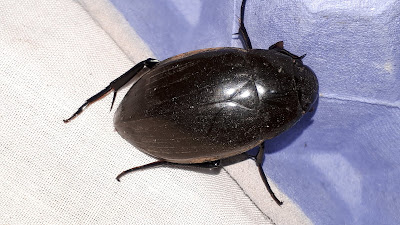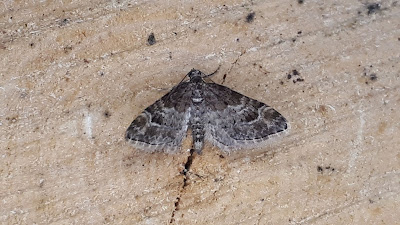Dunwich 26.4.19
After a couple of weeks without a trip out (mainly because Peter had to have major surgery!) we were super excited to get back out into the field again at the first opportunity.
We had been closely monitoring the weather forecast throughout the week to see which night would be the most suitable for trapping. The temperature and rain predictions looked best for Friday night but the wind was going to be a concern. Storm Hannah was already battering the West of the country and it had been blustery for a while here. Despite the wind predictions, the rain wasn't due until the early hours so we decided that it was on for Friday.
Due to Peter's recent illness (thankfully, now recovered!) we went in one car; although my car is a large 7 seater, it's amazing how much kit we have for a mothing session! We decided to cut down on the smaller traps because of the lack of space in the car, especially as we were slightly worried about the weather; a quick pack up might be necessary if the weather turned against us.
We were all set up shortly after 8pm with two Robinson's MVs, one Wemlite and one 7 watt LED along with our MV tripod and white sheet at base camp. We even got the beating tray out and searched the Gorse but in the windy conditions we drew a blank.
As usual, when everything is set up and the lights are on, we sit down, have a cup of coffee and wait for the moths to arrive... The sky was mainly clear but clouds came and went throughout the final couple of hours of light but the temperature was holding up at around 11 degrees and the forest was offering a bit of shelter. Finally it got dark and it was just a case of waiting to see what would arrive.
Half an hour after dark, we were still waiting for the first moth to arrive. It's always slightly nerve-wracking waiting in the dark for the first moths; would the wind stop them flying? Would the rain come early? Will the temperature drop away? We've known the weather turn from warm and sunny to icy cold within an hour...
Luckily the moths did start to arrive but not until after 9pm. As usual, at this time of year, the first moths to arrive were Water Carpets followed soon after by an Early Grey. Once the moths started to come in, it wasn't long before we had our first new moth on the list; a pair of stunning Scalloped Hook-tips arrived almost together.
 |
| Scalloped Hook-tip |
A rather tatty Lunar Marbled Brown was next in but it wasn't long before a star moth dropped in... I was sitting down enjoying a rest when I noticed a small Tortrid moth drop onto the sheet. Although I knew it was a new moth for me, I couldn't put a name to it immediately. Then Peter mentioned that he'd seen a picture of one on Facebook recently and then I remembered seeing the same... Luckily mobile internet works fine in the woods so I was able to have a quick look at a recent post by Ben Sale in Hertfordshire. There was our moth; Gravitarmata margarotana - The Pine Cone Tortrix.
 |
| Gravitarmata margarotana |
This is a relatively new moth to Britain having only been recorded since 2011 and until now was thought to only be a migrant to Suffolk. Within an hour we had 4 of these stunning little moths proving that it has established a colony here at Dunwich. In more favorable conditions I suspect we would've seen quite a few more of them.
A round of the traps produced some of the usual suspects such as Pine Beauty, Common Quaker and some Pugs but back at base camp we didn't have long to wait until the next great moth graced the white sheet... Another relatively new moth to these parts is the Dotted Chestnut. Now fully established towards the south of Suffolk, it is still very local across much of the country although it has been spreading quickly. Like its relatives, the Dotted Chestnut hibernates as an adult so this moth is now getting on a bit but it was still an exciting find for both of us; we've been eagerly awaiting its appearance closer to home for some time.
 |
| Dotted Chestnut |
Pine Beauty has been on the wing for some time now; we caught one on our first Dunwich field trip way back in February! With 28 Pine Beauty by the end of the night, it was the most numerous moth of the session but we never get tire of seeing them....such stunning moths!
 |
| Pine Beauty |
We had 3 species of Carpet in the session, Water, Red-green and Grey Pine. Grey Pine Carpet is a highly variable species and all 5 of the ones we caught were different.
 |
| Grey Pine Carpets in different forms |
The Notodontids, or Prominents were well represented on the night. All such beauties in their own way but the one we both really hoped for this time was the magnificent Great Prominent and we were not dissapointed!
| Great Prominent |
| Great Prominent |
We recorded 9 Great Prominent on the night but I suspect they would've kept coming on a longer session as they are late flyers. Other Prominents recorded were Swallow, Lesser Swallow and Pebble Prominent.
 |
| Swallow Prominent |
| Lesser Swallow Prominent |
| Pebble Prominent |
Another round of the traps produced more new moths for us including Capua vulgana and Syndemis musculana at the MVs. With the cool, windy conditions, micro moths were few and far between so it was nice to pick up these good-looking moths.
 |
| Capua vulgana |
 |
| Syndemis musculana |
The wind was really starting to pick up by midnight but with new moths still appearing at the traps and at base camp all the time, we didn't want to pack up just yet... The white sheet at base camp was blowing around a fair bit and as I was trying to secure it I spotted a very pale moth buzzing around the tripod light. I'd managed to nab an Angle Shades and another Swallow prominent but my hands were full and I only managed a quick glimpse of a pristine White Ermine before it flew off into the darkness.
We packed up the small traps earlier than usual and then did a final round of the Robinson's MVs as it looked like the weather was closing in and we were beginning to feel the cold. As we were packing up the first of them we were pleasantly surprised to find this very late Oak Beauty and our first Brindled Beauty of the year.
 |
| Oak Beauty |
| Brindled Beauty |
There were a couple of interesting Pugs around the trap too. Most were Brindled Pug but there was also a Double-striped and what turned out to be our first Oak-tree Pug of the year.
 |
| Oak-tree Pug |
Onward to the last trap to pack up... Straight away I spotted a micro moth on the collar which I recognised but couldn't immediately put a name to it. I tubed it and popped it in my pocket while we added the last moths to the list. However, just as we were sorting through the last of the egg trays, it started to rain. Disaster! with 100 metres of cable to reel in plus the exposed bulb on the tripod stand still on, there was no time to lose... I legged it back to base camp and turned off the MV on the tripod plunging the woods into complete darkness! Well, we're old pros at packing up now and the rain held off just enough to avoid soaking everything. So with everything thrown into the car and a final check around, we were on our way home with smiles of satisfaction on our faces.
And about that mystery last moth of the night? It was the fabulously named Semioscopis steinkellneriana...
 |
| Semioscopis steinkellneriana |
We finished the session having recorded a highly respectable 121 moths of 31 species, 7 of which were new moths for us. It was also our highest species count of the year so far. Considering the wind and cooler temperatures, we went home very happy indeed.
Here are some some of the other moths we saw during the session:
 |
| Brindled Pug |
 |
| Brown Silver-line |
| Lunar Marbled Brown |
| Pebble Hook-tip |
| Water Carpet |
| Early Grey |
| Frosted Green |
| Red-green Carpet |
The List
Macros:
Water Carpet 5
Early Grey 2
Scalloped Hook Tip 2
Lunar Marbled Brown 2
Common Quaker 20
Dotted Chestnut 1
Pine Beauty 28
Hebrew Character 2
Brindled Pug 8
Swallow Prominent 7
Clouded Drab 2
Grey Pine Carpet 5
Great Prominent 9
Lesser Swallow Prominent 4
Red-green Carpet 1
Pebble Prominent 1
White Ermine 1
Pebble Hook tip 1
Frosted Green 5
Double-striped Pug 1
Brown Silver Lines 1
Angle Shades 1
Oak Beauty 1
Brindled Beauty 1
Oak Tree Pug 1
Micros:
Gravitarmata margarotana 4
Capua vulgana 1
Syndemis musculana 1
Ypsolopha ustella 1
Semioscopis steinkellneriana 1
Dyseriocrania subpurpurella 1
Water Carpet 5
Early Grey 2
Scalloped Hook Tip 2
Lunar Marbled Brown 2
Common Quaker 20
Dotted Chestnut 1
Pine Beauty 28
Hebrew Character 2
Brindled Pug 8
Swallow Prominent 7
Clouded Drab 2
Grey Pine Carpet 5
Great Prominent 9
Lesser Swallow Prominent 4
Red-green Carpet 1
Pebble Prominent 1
White Ermine 1
Pebble Hook tip 1
Frosted Green 5
Double-striped Pug 1
Brown Silver Lines 1
Angle Shades 1
Oak Beauty 1
Brindled Beauty 1
Oak Tree Pug 1
Micros:
Gravitarmata margarotana 4
Capua vulgana 1
Syndemis musculana 1
Ypsolopha ustella 1
Semioscopis steinkellneriana 1
Dyseriocrania subpurpurella 1
























